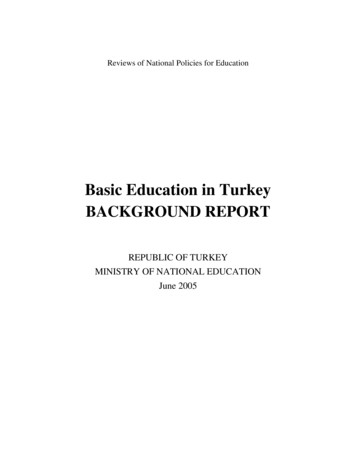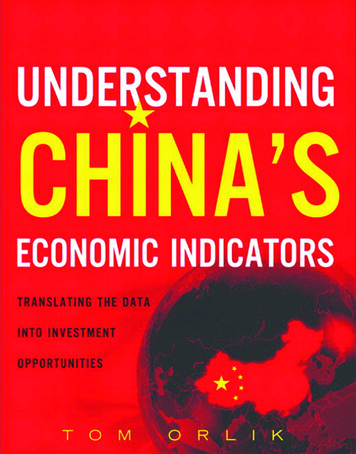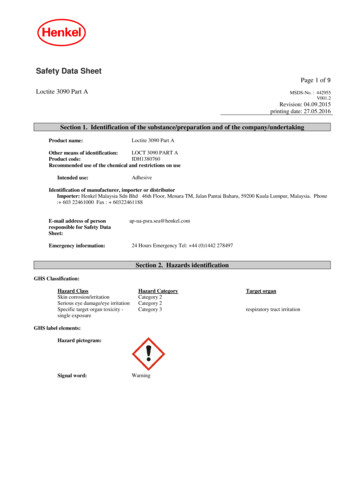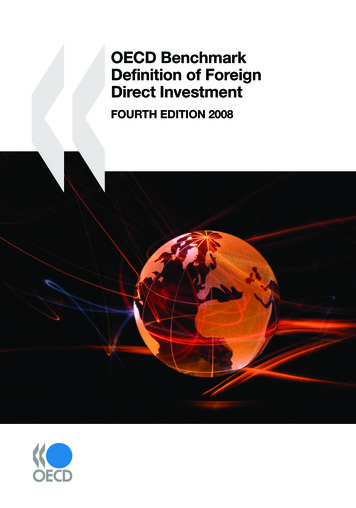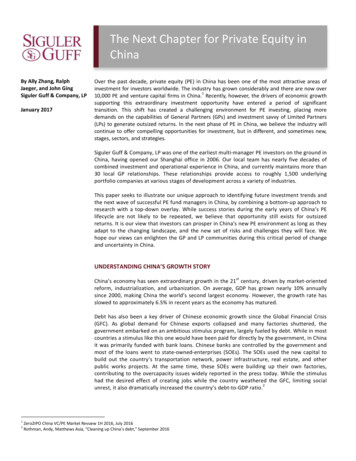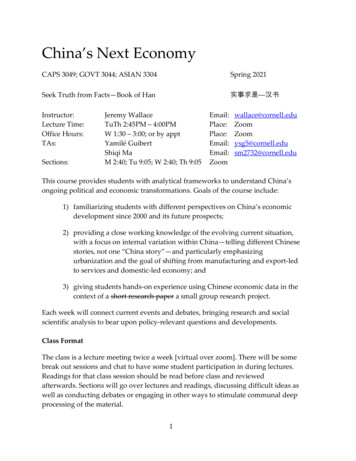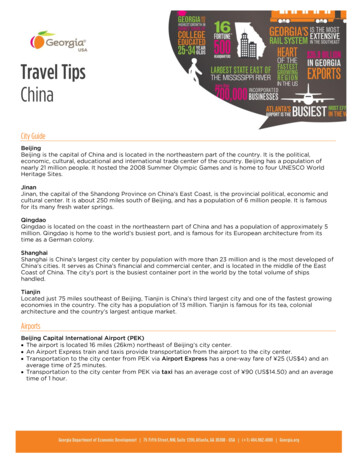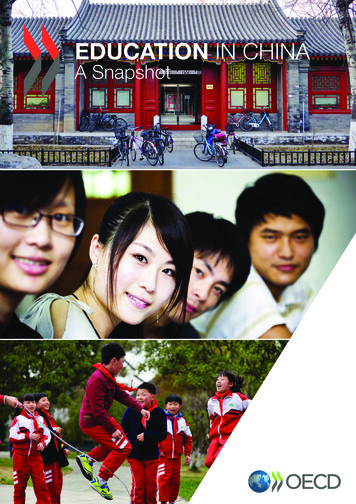
Transcription
EDUCATION IN CHINAA Snapshot
This work is published under the responsibility of the Secretary-General of the OECD. Theopinions expressed and arguments employed herein do not necessarily reflect the officialviews of OECD member countries.This document and any map included herein are without prejudice to the status of orsovereignty over any territory, to the delimitation of international frontiers and boundariesand to the name of any territory, city or area.Photo credits:Cover: EQRoy / Shutterstock.com; iStock.com/iPandastudio; astudio / Shutterstock.comInside: iStock.com/iPandastudio; li jianbing / Shutterstock.com; tangxn / Shutterstock.com; chuyuss / Shutterstock.com; astudio / Shutterstock.com; Frame China / Shutterstock.com OECD 2016You can copy, download or print OECD content for your own use, and you can include excerpts from OECD publications, databasesand multimedia products in your own documents, presentations, blogs, websites and teaching materials, provided that suitableacknowledgement of OECD as source and copyright owner is given. All requests for public or commercial use and translation rightsshould be submitted to rights@oecd.org. Requests for permission to photocopy portions of this material for public or commercial useshall be addressed directly to the Copyright Clearance Center (CCC) at info@copyright.com or the Centre français d’exploitation du droitde copie (CFC) at contact@cfcopies.com.
Education in ChinaA SNAPSHOT
ForewordIn 2015, three economies in China participated in the OECD Programme for International Student Assessment, orPISA, for the first time: Beijing, a municipality, Jiangsu, a province on the eastern coast of the country, and Guangdong,a southern coastal province. Shanghai, which, like Beijing, is also a Chinese megacity of over 20 million people, hasparticipated in PISA since 2009. These four economies alone are home to more than 233 million people – more thanthe entire population of Brazil, nearly three times the population of Germany and nearly four times the populationof France.What do we know about the largest education system in the world? A system that is educating 260 million youngpeople, and that employs 15 million teachers? Not very much. This paper aims to change that. It provides a broadoverview of how China’s education system is organised and operates, and how reforms, both past and current, havereshaped education in China over time. The report then examines in greater detail education in the four economieswithin China that participated in PISA 2015. It provides the context in which China’s participation in PISA – and itsresults in PISA – should be interpreted.This report was drafted by Yuanyuan Pan, during her internship and consultancy at the OECD, and was completedand reviewed by Sophie Vayssettes and Elizabeth Fordham, from the OECD Secretariat. Yang Cancan, from theDepartment of International Cooperation and Exchanges in the Chinese Ministry of Education, co-ordinated thereview of the report within the Ministry. The report was also reviewed by an external expert, Kai-ming Cheng,Emeritus Professor at the University of Hong Kong. Sakshi Mishra provided analytical support, and Yi Zhou wasresponsible for data checking and iconographic research. Sophie Limoges co-ordinated the publication process,Marissa Colón-Margolies edited the report, and Sara Gouveia provided administrative support.EDUCATION IN CHINA: A SNAPSHOT OECD 2016 – 3
Table of contentsChapter 1 ORGANISATION AND MANAGEMENT OF EDUCATIONIN CHINA 7Introduction 8China’s education system 9Teachers and teaching 17Student affairs 22Curriculum 23References 25Chapter 2 EDUCATIONAL REFORMS AND CURRENT ISSUES 27Introduction 28Narrowing the rural-urban gap and regional differences in education 28Reforming curriculum at all levels and focusing more on creativity 30Reducing the role of standardised testing and reforming the gaokao 31Strengthening educational inspection 33References 34Chapter 3 BEIJING 35Introduction 36Alleviating academic burdens for elementary school students 38Overcoming inequality 39Improving the quality of education 39References 40Chapter 4 SHANGHAI 41Introduction 42Pioneer in examination reform 42Enhancing equity and inclusion 43References 44Chapter 5 JIANGSU 45Introduction 46A leader in pre-school and equitable development 464 – EDUCATION IN CHINA: A SNAPSHOT OECD 2016
Redistributing resources and expanding access for migrants 47Providing a well balanced curriculum 49Note 49References 49Chapter 6 GUANGDONG 51Introduction 52Increasing investment and building partnerships 53Spurring education development in Shenzhen 54References 55AnnexesAnnex A T he responsibilities of the Ministryof Education 58Annex B ist of the Ministry of Education’sLdepartments with functions 60BoxesBox 1.1Participation in PISA.8Box 1.2Administrative divisions in China.9Box 1.3Government efforts to reform pre-school education.11Box 1.4Where are the 15-year-olds?.11Box 1.5Admission to higher education.12Box 1.6Education funding.16Box 1.7 Educational investments in compulsory educationin rural areas.17Box 1.8Basic Education Curriculum Reform.23Box 2.1Special policies for teachers in rural areas.29Box 2.2The hukou system.29Box 6.1Languages in China.52EDUCATION IN CHINA: A SNAPSHOT OECD 2016 – 5
TablesTable 1.1 The content of qualification examination in different typesof education.19Table 1.2Professional titles with requirements.21Table 3.1Student-teacher ratio ranked by teacher level.37Table 6.1Basic statistics for Shenzhen and Hong Kong.54FiguresFigure 1.1 China’s education system organisation.10Figure 1.2 Total education funds and government appropriationsfor education (2005-2014).15Figure 1.3 Government appropriations for education as % of GDP(2005-2014).15Figure 1.4 Share of expenditure on educationby source of funding (2014).16Figure 1.5 Teachers types at different levels.18Figure 3.1 Personnel engaged in science and technology activitiesin Beijing (2005-2014).36Figure 3.2 Government appropriated budgetary fundsfor education per student in regular primary school,regular junior secondary school and regular seniorsecondary school (2013).37Figure 5.1 Per capita income of urban and rural residentsby region (2014).476 – EDUCATION IN CHINA: A SNAPSHOT OECD 2016
Chapter 1Organisation andmanagement ofeducation in ChinaEDUCATION IN CHINA: A SNAPSHOT OECD 2016 – 7
IntroductionThe People’s Republic of China (hereafter “China”) is theworld’s most populous country, with a population of over1.3 billion, covering approximately 9.6 million squarekilometres. Since the implementation of economic reformand opening policies in 1978, China has become one of theworld’s fastest-growing major economies. With the GDPgrowth rate averaging between 7% and 8% a year in recentdecades, China has become the world’s second largesteconomy by nominal total GDP (World Bank, 2015).Despite China’s emergence as one of the world’s mostinfluential economies, relatively little is known in othercountries about China’s education system or about howits students learn. This report seeks to provide an overviewof education in China today, including mechanisms thecountry uses to manage its education system, as well ascurrent policies and reforms. It focuses on education inmainland China, and puts a spotlight on the four provincesand municipalities that participated in the 2015 editionof the OECD Programme for International StudentAssessment (PISA). PISA is a triennial international surveywhich aims to evaluate education systems worldwide bytesting the skills and knowledge of 15-year-old students.These districts represent not only the economic heartlandof emerging China, but also important regions foreducation innovation and development.THE STRUCTURE OF THIS REPORTThis report is organised into six chapters. The firstoutlines China’s national education system and how itworks, including the organisation of the system, and howthe government deals with educational development,reform and quality improvement, teachers, students,curriculum and teaching. The second chapter introducescurrent education reforms and relevant nationwidepolicies, including the challenge of balancing educationaldevelopment in rural and urban areas, and reformsof the examinations. The remaining four chapters areeach devoted to the four participating provinces andmunicipalities in PISA 2015.Box 1.1 Participation in PISAShanghai has participated in PISA since 2009. In 2015,China expanded its participation in PISA to include Beijing,Shanghai, Jiangsu and Guangdong. Beijing and Shanghaiare municipalities administered by the Chinese centralgovernment; they are also megacities boasting populationsof over 20 million people. Jiangsu is a province on theeastern coast of China. Guangdong is a southern coastalprovince. Hong Kong has participated in PISA since 2000,while Macau has participated in PISA since 2006. Both arespecial administrative regions of China.Basic statistics relating to Chinese municipalities and provinces participating in PISA can be found below:Municipality/ProvincePopulation(in million)Area(in km2)GDP(in CNY trillion)GDP per capita(in CNY)Beijing municipality21 51616 4102.13399 136Shanghai municipality24 2576 3402.35697 127Jiangsu province79 600102 6006.50981 771107 240179 8006.77963 213Guangdong provinceNote: All data are of 2014.Sources:Beijing Bureau of Statistics (2015), ��公报” [Beijing Economic and Social Development Statistical Bulletin 151124 327764.html.Guangdong Bureau of Statistics (2015), ��报” [Guangdong Economic and Social Development Statistical Bulletin 2 310084.html.Jiangsu Bureau of Statistics (2015), ��报” [Jiangsu Economic and Social Development Statistical Bulletin 502/t20150217 254151.html.Shanghai Bureau of Statistics (2015), ��报” [Shanghai Economic and Social Development Statistical Bulletin 4/nw12335/u21aw994813.html.8 – EDUCATION IN CHINA: A SNAPSHOT OECD 2016
Chapter 1 –Organisation and management of education in ChinaChina’s education systemChina has the largest education system in the world.With almost 260 million students and over 15 millionteachers in about 514 000 schools (National Bureau ofStatistics of China, 2014), excluding graduate educationinstitutions, China’s education system is not onlyimmense but diverse. Education is state-run, with littleinvolvement of private providers in the school sector, andincreasingly decentralised. County-level governmentshave primary responsibility of the governing and deliveryof school education. For the most part, provincialauthorities administer higher education institutions. Inrecent years, the Ministry of Education has shifted fromdirect control to macro-level monitoring of the educationsystem. It steers education reform via laws, plans, budgetallocation, information services, policy guidance andadministrative means (National Centre for EducationDevelopment Research, 2008).Box 1.2 Administrative divisions in ChinaTo manage the vast territory and huge population, China’sConstitution provides for three levels of administration,excluding the central government: provincial level, countylevel and township level. Of these, the provincial-leveldivision is the highest level of classification. The primaryresponsibility for education lies with counties for managingand delivering primary and secondary education, whereashigher education falls under the jurisdiction of provincialauthorities.Provincial-level divisions are directly administered by thecentral government. There are four kinds of provinciallevel divisions: province, municipality, autonomous regionand special administered region. Currently, there are23 provinces, 4 municipalities, 5 autonomous regions and2 special administered regions.Provincial-level governments have the right to exercise theirown management policies within the purview of the lawand under regulations imposed by the central government.Provincial-level administrative divisions can further besubdivided into county levels and township levels.Provinces and municipalities have their own localgovernments. They elect delegates to the National People’sCongress (NPC), which governs the administration ofeconomic, social and cultural affairs. A municipality hasthe same political, economic and jurisdictional rights asa province. The four municipalities are: Beijing, Shanghai,Tianjin and Chongqing.As of August 2015, there were 2 852 county-level divisionsin China. The responsibility of basic education lies withcounty-level administrations, hence efforts are made tointegrate the development of education and the labourforce with the development of the local economy and theadvancement of culture, morals and living standards for allChina’s citizens.The autonomous regions, like provinces and municipalities,have their own local governments. The central governmenthas granted the autonomous regions more legislative rightsbecause they are home to large populations of minority ethnicgroups. The special administrative regions of Hong Kongand Macau are governed by the principle “one China,two systems”. This principle guarantees autonomy to theseregions while maintaining their place in a unified China.Thus Hong Kong operates under the jurisdiction of the HongKong Basic Law and Macau operates under the jurisdiction ofthe Macau Basic Law—constitutional documents approved bythe NPC that preserve a high degree of governing autonomyin both regions.Source: National Centre for Education Development Research (2008), National Report on Mid-Term Assessment of Education for All in China, Beijing, na/China EFA MDA.pdf.THE SCHOOL SYSTEMIn China, students usually enrol in pre-school at age twoor three, and leave pre-school at the age of six. Pre-schooleducation is not compulsory, and many pre-schools areprivately owned. However, the government has taken ona more proactive role in promoting access following anational commitment to progressively universalise oneto three years of pre-school by 2020. The details of thegovernment’s efforts to develop the pre-school educationsystem are summarised in Box 1.3.EDUCATION IN CHINA: A SNAPSHOT OECD 2016 – 9
Chapter 1 –Organisation and management of education in ChinaFIGURE 1.1 CHINA’S EDUCATION SYSTEM hD programmeMaster’s programmeUniversity (bachelor’s degree) and vocational collegeSenior secondary schoolJunior secondary schoolPrimary school54Pre-school and kindergarten3Source: OECD (2015), OECD Economic Surveys: China, OECD Publishing, Paris, http://dx.doi.org/10.1787/eco surveys-chn-2015-en.In China, students must complete nine years ofcompulsory education. Most students spend six years inprimary school, though a few school systems use a fiveyear cycle for primary school. Primary education starts atage six for most children. This is followed by three to fouryears of junior secondary education. Before the 1990s,secondary schools recruited students on the basis of anentrance examination. To emphasise the compulsorynature of junior secondary schools, and as a part ofthe effort to orient education away from examinationperformance and towards a more holistic approach tolearning, the government has replaced the entranceexamination with a policy of mandatory enrolment basedon area of residence (Schleicher and Wang, 2014). Thegross enrolment ratio for primary education in 2014 was103% compared with 104% in 2006, while for secondaryeducation gross enrolment ratio was 94% compared with64% in 2006 (UNESCO-UIS, 2016)After finishing compulsory education, students canchoose whether to continue with senior secondaryeducation. Senior secondary education takes threeyears. There are five types of senior secondary10 – EDUCATION IN CHINA: A SNAPSHOT OECD 2016schools in China: general senior secondary, technicalor specialised secondary, adult secondary, vocationalsecondary and crafts schools. The last four are referredto as secondary vocational schools. Students undergoa public examination called Zhongkao before enteringsenior secondary schools, and admission depends onone’s score on this examination. The government usesexamination results from Zhongkao to assign students todifferent senior secondary schools.China has made significant efforts to expand participationin secondary vocational schools in recent years in order tomeet the country’s fast-evolving economic and manpowerneeds. In 2014, secondary vocational schools accountedfor a little less than 22% of total senior secondary schoolenrolment in China (UNESCO-UIS, 2016). Although seniorsecondary education is not part of compulsory educationin China, in 2014, 95% of junior secondary graduatescontinued their study in senior secondary schools(National Bureau of Statistics of China, 2015). This figureis notable because in 2005 only around 40% of juniorsecondary graduates attended senior secondary schools(National Bureau of Statistics of China, 2005).
Chapter 1 –Organisation and management of education in ChinaBox 1.3 Government efforts to reform pre-school educationIn China, pre-school education is an important socialservice provided by the government. County-levelgovernments administer pre-school education, while thecentral government formulates laws, regulations, policiesand development plans. Local governments at all levels areresponsible for coordinating the development of regionalplans and specific policies, and they are also responsiblefor the daily management of kindergartens. The Ministryof Education is responsible for the formulation of policiesand standards, as well as the management and professionalguidance of the kindergartens.To meet the education needs of pre-school children, theChinese government plans to universalise pre-schooleducation by 2020. To achieve this goal, county-levelgovernments implemented the Three-Year Pre-schoolEducation Action Plan. This law requires that governmentsTertiary education in China experienced a hugeexpansion in the first decade of the 21st century.The gross enrolment ratio of tertiary educationthroughout China increased from 21% in 2006 to 39%in 2014 (UNESCO-UIS, 2016). During this period, variousinstitutions and programmes were established andinternational mobility and cooperation were promoteddramatically. As a result, the tertiary education systembecame more diverse. In China, undergraduate degreesat all levels actively increase budgetary investment in preschools. As a result, local governments across China have builta large number of public kindergartens. At the same time, thecentral government has encouraged private individuals andgroups to establish private kindergartens. In 2014, the grossenrolment rate in three-year pre-school education reached70%, a figure which represents an increase of nearly 20% overfive years. (National Bureau of Statistics of China, 2015).In order to improve the quality of pre-school education,the Ministry of Education has issued other relevantdocuments such as Regulations on the Management ofthe Kindergarten, Kindergarten Working Regulations, andProfessional Standards for Kindergarten Teachers. Throughthese documents, Chinese governments at all levels arestrengthening oversight of kindergarten enrolment, safety,student health, education quality and so on.require four years of study. Associate degrees take threeyears to complete, and students spend two to threeyears completing a master’s degree. A doctoral degreerequires five years of study after a bachelor’s degree, andthree years after a master’s. In addition to these tertiaryeducation programmes, Chinese students can also enrolin professional higher education programmes, whichnormally take three years.Box 1.4 Where are the 15-year-olds?Most Chinese students start primary school when theyare six or seven years old, as is required by the Law ofCompulsory Education. After nine years of compulsoryeducation, students will choose whether to pursue furthereducation at the age of 15. As a matter of course, some15-year-old students do not enrol in secondary school. Forthose that do, they can opt between the general (academic)track or vocational track. Additionally, there are four kindsof general secondary schools: regular senior secondaryschools, combined senior secondary schools, regular highschools and 12-year schools which enrol students startingin primary school. In 2013, 8.2 million Chinese studentswere enrolled in regular senior secondary education, and6.7 million were enrolled in secondary vocational education.However, the number of students graduating from juniorsecondary schools in 2012 was about 16.6 million, whichmeans about 10% of graduating students did not attendschool after compulsory education (National Bureau ofStatistics of China, 2014).Until 2014, students were permitted to sit for the collegeentrance examination only at their place of hukouregistration. This policy had immense implications formigrant children, who had to return to their home provincesin order to continue their educations. Beginning in 2014,some local governments began implementing changes sothat children of longer term-migrants could sit for collegeentrance examination in their hosting provinces.Source: National Bureau of Statistics of China (2014), China Statistical Yearbook 2014, ions to undergraduate programmes are based onstudents’ college entrance examination (gaokao) scores.A few exceptional cases are considered without theexamination scores. Admissions at the graduate level arebased on another entrance examination. However, somestudents are admitted due to recommendations.EDUCATION IN CHINA: A SNAPSHOT OECD 2016 – 11
Chapter 1 –Organisation and management of education in ChinaBox 1.5 Admission to higher educationGaokao, or the National College Entrance Examination,is required for admission to higher education in China.Students take this exam after completing secondaryschool.The Chinese Ministry of Education works closely withprovincial education authorities, universities and collegesectors to set all policy matters relating to higher educationenrolment, and to assure that enrolment policy falls inline with central government priorities. The Ministryof Education oversees policy implementation, and setsguidelines for senior secondary curriculum contentand examinations. The Ministry also oversees gaokaoexamination content. The provincial education authoritiesare responsible for gaokao student applications, conductingexaminations, managing enrolment and setting policyaccording to provincial needs under the guidance of theTHE MINISTRY OF EDUCATIONThe Ministry of Education of People’s Republic of China isthe agency of the State Council that oversees educationthroughout the country. State Council is the chiefadministrative authority in China and is chaired by thePremier. It is responsible for carrying out the policies ofthe Communist Party of China as well as the regulationsand laws adopted by the National People’s Congress. Itsresponsibilities can be found in Annex A. Currently, thereare 27 departments, whose functions are described inAnnex B.At the provincial level in China, there are departmentsof education or commissions that are in charge ofeducation. At the county level, bureaus of education arein charge. Policies and strategies designed by the Ministryof Education are implemented by local departments ofeducation, or universities under its direct management.Local education authorities, departments and bureausof education often formulate policy documentsthat correspond to national policy and include localadjustments and guidelines for specific implementation.As policies are implemented by local governments, morepractical guidelines are added. As such, policies generatedby the central government aim to set general goals ratherthan dictate specific methods. By the time these policiesand strategies arrive in the schools and other relevantinstitutions, they include practical guidelines.Currently, the Ministry of Education directly manages32 educational organisations and 75 universities. Theseorganisations promote a wide range of educationalactivities, such as educational research, educationalpublishing and media, service and associations. Some ofthese organisations play important roles in operating thewhole education system.12 – EDUCATION IN CHINA: A SNAPSHOT OECD 2016Ministry of Education. Universities bear the third levelof administration responsibility for enrolling studentsaccording to the guidelines set by the Ministry of Education.For universities administered at the national level, theMinistry of Education sets enrolment quotas in consultationwith each university. Universities administered at theprovincial level
overview of how China’s education system is organised and operates, and how reforms, both past and current, have reshaped education in China over time. The report then examines in greater detail education in the four economies within China that participated in PISA 2015. It provides the context in which China’s participation in PISA – and itsFile Size: 2MB
